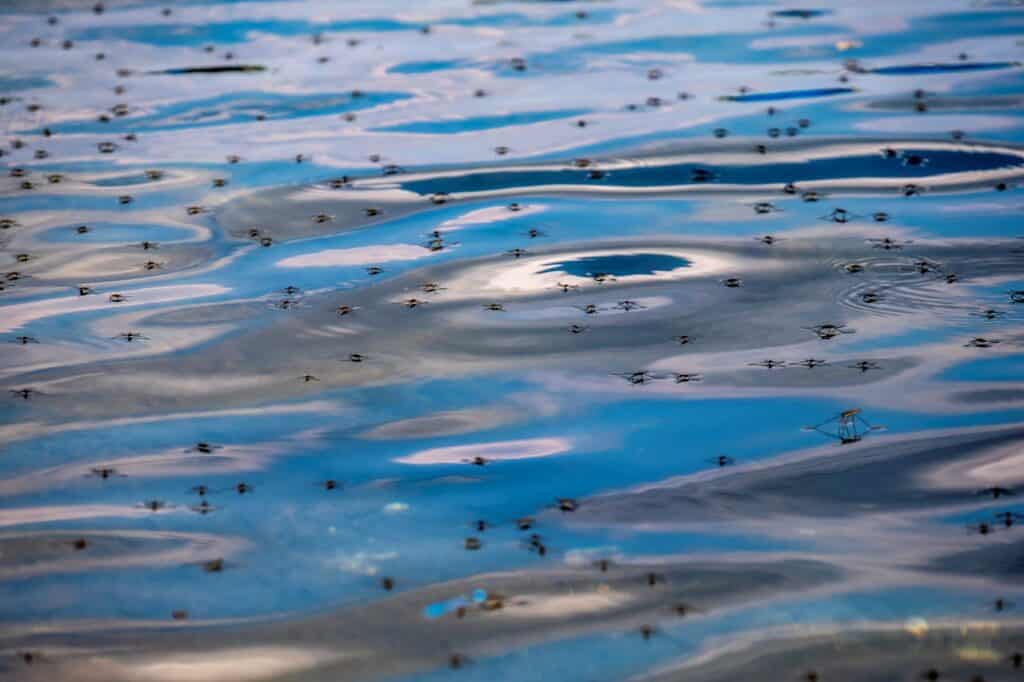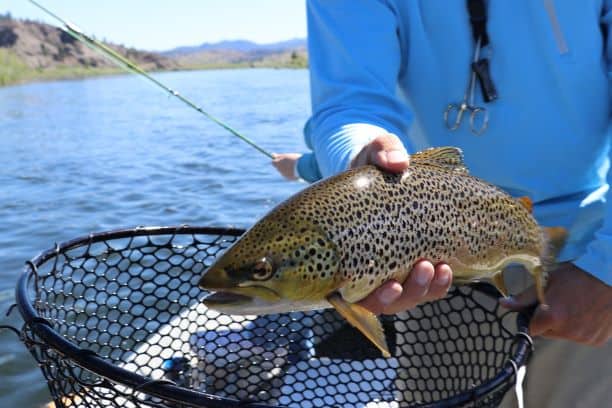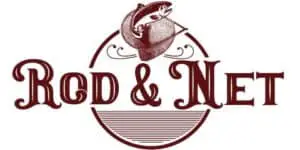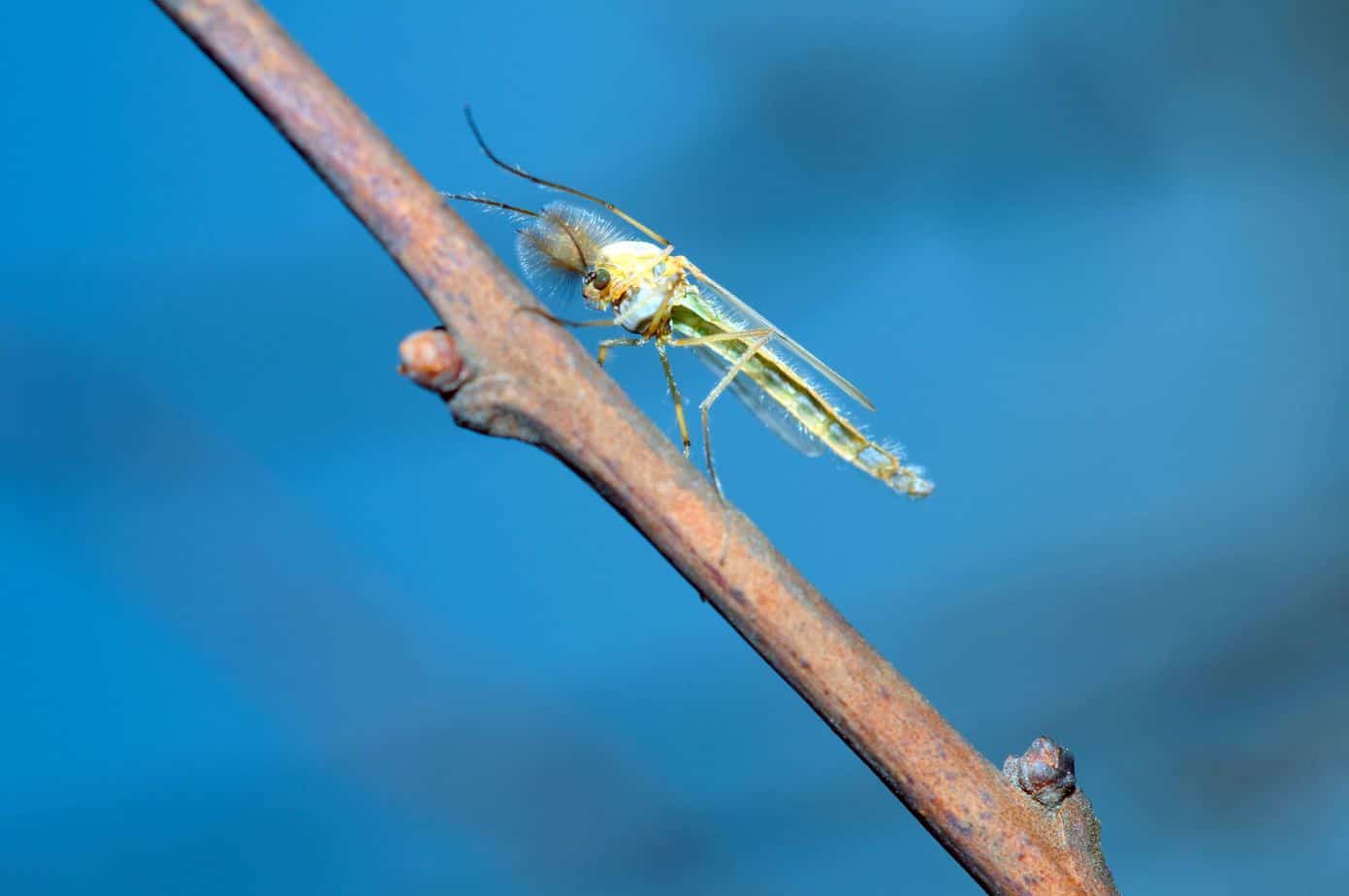Believe it or not, there are lots of fly fishing styles. One of the more popular is midge fly fishing. Precisely what is midge fly fishing?
Midge fly fishing is when an angler uses fly fishing flies that mimic one of the common midge’s lifecycle stages. Midges are harmless relatives of mosquitoes and are one of the favorite foods of trout. They’re born in the water and wriggle their way to the surface.
Even as adults, midges skim across the water in clusters, always near the fish that eat them. By copying the patterns of the midge, you can increase your catch rate overnight.
Where Do Midges Come From?
Midges are the perfect pick for a fly because of their life cycle.
Adults lay eggs that sink to the bottom of the lake bed, which pupate and turn into “nymphs” that go up through the water and mature on the surface to start it all again.
There is something called “nymphing.” What is Nymphing? Read our beginner’s article to learn more.
This lifecycle gives three main ranges depending on what fly you choose to use, and many techniques to best assimilate your fly with the fish’s environment.
First is the larva form. The midge worms can often squirm their way into the soft riverbeds to hide. Trout hunting for midge larva will stay near the bottom of the lake, out of sight.
The nymph form can be found throughout the water, swimming for survival. Nymphs have a broader range in the water column and so do the trout that hunt them.
On the surface level is where midges mature into adults and gain their wings. As a result, they’re not as easy to eat, and trout don’t often get the chance to have one. But that’s not to say they won’t try.
Understanding when and where to use your flies is key to midge fishing. It’s all about trickery. Fish aren’t smart, but they do have brains.
They know enough to see your fly is out of its place in the ecosystem and won’t be inclined to bite at it if it doesn’t look real.
What Is A Good Midge Fly Pattern?
There are over a thousand species of midge flies. Fish can be discerning for what kind is typical to be in its waters.
Midges are fragile and tiny, too small to hook on as live bait. However, the variety of midge fly patterns and trout’s eagerness still make them one of the better fly fishing options.
A basic midge fly is made from wire and fabric, around a size 20 hook or smaller.
If you’re looking for a great assortment of midge flies, check this set of Feeder Creek Fly Fishing Trout Flies on Amazon.
The midge larvae fly has a small worm-like shape with segmented tube bodies. Most of the time, they’re black, but some water conditions can turn them blood red.
The more they develop, the more limbs they’ll acquire. Adding hair on will upgrade a fly from the larva stage to the pupa or nymph stage.
The rarer flies for midge fishing imitate adults meant to float on or just under the surface.
The most popular kind of midge fly is the midge nymph. It’s a vital portion of the trout’s diet, especially in colder months.
These midges are under the surface, which means your fly will have to have some depth added to it to entice the fishes in the appropriate section of the water. However, once added, it can lead to more frequent catches than dry surface flies.
Variety is key. Failing to snag a bite with one lure means it’s time to move on to the next.
Here is another midge assortment on Amazon that can work great.
You’ll want to investigate what kind of midges live out on a given lake or river that you’ll be fishing in. You should try to have the correct fly picked out before your first cast.
Consult a local fly shop for specifics on your location. Alternatively, hire a fly fishing guide. Wondering, “Should I Hire A Fly Fishing Guide?” Read that article for some great advice.
That’s what’s so special about midges. They’re practically everywhere. It’s not a question of if they’ll work. It’s a question of when.

When To Fish With Midges
Another great thing about midges is that they are around all year long. Their life cycle is only a few weeks long, and they are less active in the winter, but they’re still there, and the fish always look for them.
Even in waters where food can be scarce, trout can survive cold weather by eating midges.
A fish will always be glad to see midge and take a chance at it in the winter. In the summer, there might be so many your fly will trick them. As long as your setup is clean, you can fish at any time of the year.
In general, When is Fly Fishing Best?
Use the time of day to your advantage too. In the early morning is when most pupae start to emerge. Hatches can last all day in cooler months, giving more use for your low and mid-level flies. You can always use two dries for two life periods as the day goes on.
Try a pupae sinker with a lighter floater of an emerging nymph to cover the mid-range. Towards the end of the day, you can use an adult floater when the rest of the bugs come out.
Where To Midge Fly Fish
Trout are accustomed to lakes, streams, and rivers, and so are midges. The bugs prefer still water and will gather around any slack water in a moving bed around rocks or other obstructions.
Midge adults will usually cluster around rocks, and trout will be nearby for a chance at a meal.
We use this technique often here in Ohio. Yes, I said Ohio. Ohio has excellent fly fishing. Read more here: Best Fly Fishing in Ohio.
Keep in mind the water ecosystem you’re fishing and where the bugs will most likely congregate. Then, target your cast in that direction. The fish will be nearby waiting.
Because these spots will be more popular with real food, you may need to use a fly that stands out more. Separate it from the crowd, and a curious fish will bite.
Depth is the hardest part. That goes for pretty much all fishing. The emerging patterns of midges between the pupae and nymph phase is where they’re most vulnerable.
Fish are smart enough to know where in the water their prey is supposed to be. An odd fish may bite regardless, but it’s not as reliable as the smart ones who have memorized the cycle and its locations.

Midge Fly Fishing Gear
Knowing all the patterns and placements won’t do you any good if the rest of your gear isn’t up to the task.
Let’s see if you have the right tools for the fish you’re fishing.
A 9-foot rod is a great place to start, either 4 or 5 weight to give you enough torque, like this Orvis Encounter 5-Weight 9′ Fly Rod Outfit from Amazon.
Midge fishing isn’t about the possibility; it’s about the opportunity. You’re getting a fish that day, so you need gear to reel it in.
You’ll want a variety of leaders to match the type of flies you bring.
Tapered leaders, 5X to 6X, from 7 ½ to 9 feet long, are a good starting point.
Fluorocarbon tippet is best used for nymph flies, whereas dry flies and adult stage patterns are better with monofilament because it floats easier.
Rig it all up at home before you go so you’re not worrying over setting up hooks while you’re knee-deep in the water. Time spent rigging is time, not fishing.
These are sometimes called a nymphing rig.
Set up ideal rigs for at least one of each kind of fly and separate them by their place in the life cycle.
That makes transitioning throughout the day much easier, and if one doesn’t work, you can quickly shift strategies to stay one step ahead of the fish.
What Does A Beginner Fly Fisher Need?
Conclusion
Hopefully, this has given you some fundamental insight into what midge fly fishing is.
If you’re already a seasoned fisherman who hasn’t considered baitless fishing before, this can be an opportunity for a new kind of fly fishing style.
Midge fishing is similar to mayfly fishing. Read “Best Mayfly Patterns.”
If you’re already a seasoned pro, perhaps this can refresh your memory on new techniques worth trying.
Midge fly fishing is a perfect entry point and step up into the world of fly fishing. It’s challenging to learn, but when it works, it keeps working. These techniques can turn any fishing spot into a fly fishing hot spot where the catches come all day.


